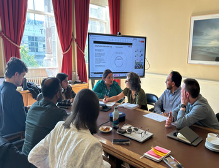Here is a blog that I wrote in February this year, around the time that I was working with the UK government Open Innovation Team with one of their projects looking at the use of AI in the NHS. My analysis feels even more fitting six months on!
The last few months have been particularly tough for the UK health system. Pressure on its services has been building for some time. Now many fear that the effort needed to respond to the recent pandemic may well have driven it beyond repair. In January 2023 Amanda Prichard, head of NHS England, admitted that the NHS is under more extreme pressure now than it was at the height of the pandemic and may not recover from the disruption and fallout caused by Covid for several years.
The challenges being faced in the NHS undoubtedly have a variety of causes leading to its current poor state of operation. A review of the UK health system by the European Observatory on Health Systems and Policies in May 2022 found that the UK has lower levels of doctors and nurses, hospital beds, and diagnostic equipment than most other high-income countries. One reason why staffing levels are low is the high level of unfilled posts. At the end of 2022 there were over 133,000 job vacancies, a rate of almost 10% of the workforce. As a consequence, waiting lists for elective care are growing with over 6 million people in England on a waiting list in 2022.
While many aspects of the NHS could be cited as contributing to its difficulties, it is important to recognize that one of these is the slow progress and high expense of its digital transformation efforts. As with every large established organization (LEO), the NHS has invested significantly in new digital technologies in an attempt to speed up operation, automate high-cost people-centric activities, and introduce technology-led innovation to improve the quality out its patient outcomes. Despite notable highlights, in many respects this digital transformation is viewed as a failed effort.
Delving into the reasons for the slow progress of the NHS’s digital transformation we can obtain several important insights into why such efforts struggle to advance and where to focus to accelerate their impact.
The Whys and Wherefores
An investigation in 2019 by the National Audit Office (NAO) into the NHS digital transformation activities delivered a sobering and rather downbeat review. It describes the state of digital services in the English NHS and examines its readiness to deliver digital transformation. It concluded that the NHS has not made the expected progress over recent years, citing the failure to meet the goal of moving to a “paperless NHS” as a prime example. Perhaps more worryingly, the report brought into question the current funding plans, challenged the lack of clarity in the aims and objectives for the programme, and openly criticized the governance approach being used to manage progress and build confidence in the digital services being offered.
One key factor in the slow adoption of digital technology that the report highlighted is that earlier costly IT failures have reduced confidence in the current programme. In 2015 the UK National Program for IT (NPfIT), an information technology upgrade to computerize patient records, was all but abandoned having spent an estimated £10B. Considered the world’s largest civil IT programme, its failure highlighted the complexities involved in attempting broad digital change in this environment and questioned the NHS’s capabilities for managing and delivering largescale IT change activities. Furthermore, the NAO review commented that they are not convinced that lessons learned from those costly errors are now being applied to overcome the complex delivery challenges being encountered and to manage the risks from operating in a volatile environment.
What’s To Be Done?
The challenges facing the NHS are substantial and cannot be easily remedied. There is no “magic wand” to help us wish them away. No single stroke of the pen can be used to define a revised policy or fund a new initiative. However, digital transformation is accepted as a critical component of any sustainable recovery. Consequently, it is important to explore the combination of elements that together may help to drive the NHS in a useful direction.
Experience working with LEOs to define and deliver digital transformation points to three key areas where progress is required. We can summarize these as: Opening up, Joining up, and Smartening up.
Opening up
In complex environments such as healthcare, it is essential that systems and solutions are made accessible to all stakeholders. Despite the challenges of operating in an area where privacy and security is vital, efforts must be made to create the conditions that allow broader inputs and wider participation. Typically, this requires focus in 3 areas:
- Supporting increased interaction with end users to encourage co-creation with clients and stakeholders to improve service provision and outcomes.
- Allowing greater transparency of data, activities, and processes where possible so that individuals gain agency over their own personal data, suppliers can compete for products and service provision, and systems are exposed to increased external scrutiny.
- Bringing new ideas, solutions, suppliers, and practices into the healthcare sector by adoption digital ways of working and making this domain an attractive workplace for a more diverse set of entrepreneurs and employees.
Many efforts are underway in this area. One of the clear (if controversial) directions being led in the US healthcare system is to open up care provision to the BigTech companies. For example, Google Health is focused on providing improved healthcare by improving health information and building products powered by that data to improve diagnosis and offer a more connected experience. Similarly, at Amazon Webservices (AWS), their AWS for Health activities and Amazon’s recent acquisition on One Medical show their intentions to build on their accessible, efficient infrastructure to automate key parts of the healthcare process. A critical focus today is how to open up the UK health system in this way while protecting the public nature of these services to be open, fair, and accessible to all.
Joining up
Much of the focus for improving the current state of the UK health system is aimed at ways to join up key elements of the many different organizations, systems, and solutions in place today. Currently, clinical healthcare issues are exacerbated by a range of difficulties when connecting between departments in the same organization, across local authority boundaries, and between the public and private sector care providers. Accelerating care pathways requires removing inefficiencies across internal operational silos.
In addition, the difficulties joining up across different aspects of the healthcare system are bringing disparities between communities and individuals across different parts of the UK. In areas such as community care and social care, making informed decisions is hampered by the inability to connect data from different sources, move staff from one area to another, coordinate transportation from one region to another, and so on.
As a result, joining up systems and services is now high priority in the UK healthcare system. While several different challenges must be tackled to make progress, it is recognized that integrating back office information systems, and coordinating between frontline services and back office management functions, form a key component of any solution. The goal is to create a connected digital platform and ecosystem that will improve the value of services provided.
What would this platform look like? An interesting example of a digital platform for joining up health systems can be seen in Salesforce’s new Patience 360 for health innovations. This is one of several commercial digital platforms that is targeting improvements in healthcare to offer personalized patient intelligence by bringing together a variety of systems such as records management, behavioural health, therapy management, and care coordination on a common technology base. Digital health records management and coordinated information sharing will continue to be a major elements of the UK digital strategy in this area.
Smartening up
Perhaps the most high-profile focus for digital transformation in healthcare has been adoption of digital tools and technologies to automate tasks and increase the quality of treatments. The broad adoption of “smarter” technologies is considered essential to improve services and overcome staff shortages. There is no doubt that over the past few years digital technologies have been critical to improvements in areas such as diagnosis and treatment recommendations, patient engagement and adherence, and administrative activities that surround the healthcare process.
A wide variety of digital technologies are now embedded in healthcare practices and this adoption will only increase. In recent months, there has been a great deal of discussion about the use of digital advances such as Artificial Intelligence (AI) in healthcare. This interest is aimed at two areas.
The first is a recognition that AI is now capable of automating many tasks previously carried out by people, and can do so efficiently and at lower cost. As a result, much as we are seeing elsewhere, AI is being introduced in areas as diverse as managing appointments to detecting abnormalities in x-rays. Such adoption will rapidly move forward.
In the second, AI techniques are being used increasingly to improve wellness, adjust lifestyles, and help prevent existing condition from worsening. Often associated with fitness tracking and exercise, a variety of digital technologies and approaches are now widely being deployed to understand more about individuals and communities. Individuals are using these devices to understand their own health trends. In the healthcare profession, amongst other things, this data is helping to manage treatments and adjust care pathways.
Many schemes and approaches involving the use of AI technologies are now being deployed with many implications on health outcomes and on the workforce responsible for healthcare. One key area that is critical is to define the current and future skills needed in the healthcare system. The hope and expectation is that the smarter, more intelligent digital technologies being used in healthcare will not only improve the lives of patients, but also the daily activities of healthcare practitioner, administrators, and workers. Yet, how this will be achieved effectively in the current recruitment difficulties and financial crisis remains open to question. Indeed, getting the right digital skills into the NHS is seen by some as the biggest challenge it faces.
A Healthy Start
The pressures on our public health systems are enormous and increasing. Undoubtedly, digital transformation in healthcare will be a critical element of how we respond to overcome the challenges and deliver a more accessible, better, and fairer service to all. Unfortunately, reports of poor results from past efforts in digital reform of the health system in the UK have eroded confidence and lowered expectations. Addressing these concerns requires three key areas of focus for digital strategy: Opening up, Joining up, and Smartening up.
Originally posted on Alan’s Digital Dispatches






